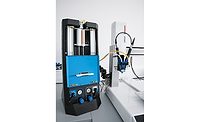
Mixing and dosing stations based on the “endless piston principle” allow reliable precision dosing of two-component materials. Compared to conventionally applied systems, this new application technology can offer excellent dosing repeatability of medium- to high-viscosity adhesives and sealants.
Modern production processes increasingly involve two-component materials. The automobile industry tops the list, followed by the manufacture of electronics, solar technology, aircraft, trucks, sports goods, commodities and even clothing. All of these industries rely on adhesives, sealants, fillers and other insulating materials that are made from two-component materials.
The most significant feature of two-component processing is that mixing both components in their correct proportions enables the adhesives to cure to reach their ultimate strength at the production stage, and not before. This offers considerable advantages for the storage of raw materials, as well as the application process itself.

The new two-component dispenser can operate in highly complex industrial applications or as a low-cost tabletop unit.
Rheology Demands Flexibility
The wide range of industries requiring two-component materials naturally gives rise to a variety of requirements and properties, such as dielectric strength in electronics, density, and ultimate strength of adhesives or shrinkage during the filling and casting processes. As a result, a huge variety of materials-all with different viscosities, fillers, mixing ratios and thixotropic properties-is now commercially available; the majority of these are silicone, epoxy resin or polyurethane-based products.The abundance of available materials is good news for processors of adhesives, as it is easy for them to obtain the exact products they require for a particular application. System manufacturers, on the other hand, consistently have to deal with the constantly changing rheological properties of the materials used. Parameters such as filler content, viscosity, or flow limits play a critical role, particularly in the automated mixing of two-component materials. The ever-shorter opening times are favorable for growing cycle time requirements, but they are challenging for the system manufacturer.
In addition to dosing accuracy, the main objective for the optimized automation of such applications is the realization of constant, exact mixing ratios. It is here that rheology exerts its influence. Figure 1 shows a typical system layout for a two-component application for larger quantities; it consists of a material supply, two pumps, a certain length of hose relevant to the size of the system, two flow meters, two valves, one mixing head, and the (usually) static mixer.
As previously mentioned, the flow properties of the products, as well as the individual components of resin and hardener, vary significantly. Thus, if the dosing pumps start simultaneously, different rates of pressure expansion will be produced in the lines, resulting in fluctuations in the mixing ratio at the beginning and the end of the dosing process. To offset this, complex electronic control systems that involve pressure buffers, valves and various hose diameters are used. When changes in rheological properties occur, adjustments often have to be carried out. Temperature fluctuations occurring in the course of a day and a year will usually lead to an unstable result.

Figure 1. Schematic of a Standard Two-Component System with Gear Pump
The Endless Piston Principle
A two-component dispenser based on the endless piston principle was developed to provide a solution to these challenges (see Figure 2). The volumetric dosing pumps work independently of viscosity or counterpressure and are placed directly in front of the mixing tube. Due to their lack of dead space and short conveying distances, the flow properties of the dosing media have no impact and mixture fluctuations are alleviated.As can be seen in Figure 3, the dosing pumps are connected to the mixer inlet via single, optimally streamlined channels, so the products to be mixed are kept separate until they reach the static mixer. Analog pressure sensors, which are flush-mounted to eliminate contamination, monitor the dosing result and protect the pump from overpressure caused by product hardening in the mixers.
At the end of dosing, the pressure reduction can be adjusted individually for each component by a defined reverse-flow, which prevents dripping from the mixer. The components are available immediately in the correct ratio for a new dosing sequence to start. The feed of product to the mixing head is a considerably less sensitive operation, with pressures ranging from 0 to 20 bar, provided that the dosing pumps are properly filled. The system can process viscosities ranging from 0 to 2 million mPa, while mixing ratios are between 1:1 and 100:10, provided static mixing is present.

Figure 2. Endless Piston Principle
Easy System Integration
The new two-component dispenser, combined with the ad hoc control system, can operate in highly complex industrial applications or as a low-cost tabletop unit, depending on the requirement. The unit is designed for bead and dot applications, as well as volumetric filling, and provides continuous monitoring of all process parameters (e.g., pressure, product supply, open time, etc.).The unit can be easily installed in existing systems, and the supply tanks do not have to be replaced in most cases. The lightweight (8-9 kg, depending on the drive technology) two-component dispenser can be integrated into almost any robot or XYZ system. Since the dosing pumps are completely linear, they can be combined with practically any type of variable drive, and system manufacturers are able to continue using their own drive technology. The analog evaluation of the pressure sensors allows the pressure curve for every dosing sequence to be transferred to a process control system for recording, thus ensuring 100% control.

Figure 3. Two-Component Dispenser Design Based on the Endless Piston Principle
A Practical Example
With the aim of increasing production efficiency and improving quality, a well-known kitchen appliance manufacturer sought new solutions for the application of two-component adhesives. The task involved sticking aluminum strips onto glass sheets; the existing dosing system could only produce long adhesive beads. Small dot dosing resulted in too much adhesive being dispensed, and large quantities of product accumulated at the start and stop of application.In collaboration with a system integrator for high precision and flexible automation solutions in assembly robotics, test engineering, and plant design, a complex dosing cell using the new dosing head was designed for the application of two-component adhesives. One advantage of the dosing cell is that the programming of dosing parameters, as well as axis systems, can be varied in defined limits in a graphical interface. A recipe memory stores all possible variations of the assembly parts, and the production program allows the selectable application of small dots and long beads for each part. Since no separate dosing controls are required, the communication and coordination problems that often occur in conventional dosing systems are avoided.
The user of this system* is now in a position to manufacture all variations of assembly parts using only one dosing cell. The company can easily change from one adhesive application to the other (i.e., from the smallest dots to lengthy beads) while being sure of a precise and uniform result every time.
Because it is already well-established in the market and in two-component technology, the endless piston dispenser was the obvious choice of dosing technology for this application. All of the desired features, including simple operation, absolute reliability, easy integration and maintenance, broad application capability, and lightweight construction, were combined to develop the two-component dispenser.
For more information, contact ViscoTec-America Inc. at 975 Cobb Place Blvd. NW, Suite 201, Kennesaw, GA 30144; phone (770) 422-4281; or visit www.viscotec-america.com.
*The system was built by Axelius Automation GmbH.


